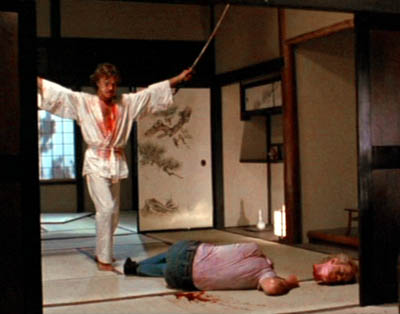|
I know it sounds like a documentary about Trump Tower, or maybe 1600 Pennsylvania Avenue, but in fact it is a Japanese samurai ghost story. Usual deal. What, you've never seen one of those? Oh, OK, you've twisted my arm and I'll tell you about it. It begins with a scene set in 1840, near Kyoto. A bald-headed samurai warrior approaches a house. Well, I guess he's a warrior, because he has a very large sword tucked into that obi around his waist. You'd have to guess that he isn't a fisherman or a farmer, and he's probably not a chef because this was years before Benihana's. I ruled out pirate. No parrot. He sees a beautiful woman in the doorway. He enters. They engage in a courtship ritual, in which they sip some tea and exchange glances. They then get on to the actual courtin', in which they exchange more than glances and she sips her tea from the ol' samovar of love. Wink, wink, nudge, nudge. Another warrior approaches the same house. This guy must be a higher-ranking bald-headed warrior, or at least a more prosperous one, because he has two swords tucked into his sash. He looks at the paper walls and sees the silhouette of the lovers embracing, and hoo-boy is he pissed off. We realize that it must be his house, and the woman must be his wife. He shows that those Ginsu swords can slice and dice through walls, furniture ... even tin cans! Isn't that amazing? Eventually he uses the swords to chop off the other guy's right arm, and then his dick, and so forth, until the other guy looks like the Black Knight in that Monty Python movie. Mr. Two Swords then slices and dices his wife. For his grand finale, the disgraced warrior kneels down and commits hara-kiri. Already we have learned two valuable lessons for our next assignment in Japan:
The film then picks up the main story in 1982, when the real estate agent for that house finally finds a tenant - the unsuspecting American family of a writer. "Wow, honey, what a deal. It's a twelve bedroom house on a hillside with an elaborate garden, and it's only three dollars a month. And everyone said Japan was so expensive." Of course, the prospective Japanese renters can read the sign and avoid the 邪悪な家. The Japanese know that the sign means "house where evil dwells," but the Americans can't read Japanese, so the real estate guy translates it into English as "future site of McDonald's", and the Americans are none the wiser. Of course, the house is now inhabited by the ghost of the three Japanese people who died there in 1840. Amazingly, the three of them get along just fine now in the afterlife, and really seem to enjoy their post-death entertainment, which consists of playing evil pranks on the new people who enter the house. Their powers basically consist of the ancient ceremonial "Froggy Gremlin" ritual, which is called in Japan "plucking the magic twanger." (Rough translation.) For you younger readers, Froggy was a little dickens from the Buster Brown kiddie show. He would always pop up in a puff of smoke, seemingly from nowhere, to plant words into a lecturer's head through subliminal suggestion, words which the lecturer would then repeat without thinking. When the kids would laugh at what the serious lecturer conceived to be a somber moment, it would suddenly dawn on him what he had just said. Example:
I used to find this hilarious when I was little. Come to think of it, I still laughed twenty years later when some comic (Albert Brooks??) turned it into a comedy piece with Froggy Gremlin using his powers on Richard Nixon, forcing Nixon to tell the truth inadvertently. Anyway, these three Japanese ghosts have the same subliminal suggestion power as Froggy. The director shows them superimposing themselves upon the living, at which point the ghosts are exercising some mind control. Example:
|
|
|
Well, you can guess that their marriage is going to get a little rocky after a few dozen exchanges like that. Of course, it will inevitably result in her sampling Alex's own bald-headed warrior. (Hey, how often do you get to see a 50ish Doug McClure naked?) Eventually it will result in a closing sequence which is a re-creation of the opening sequence, except that the fight is between Edward Albert and Doug McClure, who are in turn being possessed by the two Japanese ghost-warriors (right). This film has some very good moments, especially in the opening scene. It also has some beautiful photography. Unfortunately, it has two elements which kill it as a ghost story:
|
 |
| Since the audience is forced to wait too long between the scares, and since half of the scares come out silly rather than frightening, the film just doesn't work. On the other hand, my overall impression of the film is not what I expected from the cellar-dwelling 3.4 rating at IMDb. As I watched this, I didn't feel that I was watching a terrible, cheesy movie, but rather one that was a regrettable failure, because it could have been a good genre flick with just a little more thought put into it. (I suppose I wasn't the only one who felt that way because Ju-on: The Grudge is based on a very similar premise.) The opening scene is quite effective, and the Americans' arrival in Japan is workmanlike, but then the whole film collapses like a house of evil cards. In other words, it's a ghost story that seems pretty damned good until the ghosts show up! | |
